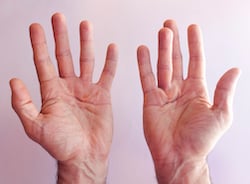 A little-known hand condition, Dupuytren's disease, wreaks havoc on patients suffering from its debilitating impact. How medical professionals treat the disorder can have lasting ramifications. The earlier intervention begins, the better the outcome.
A little-known hand condition, Dupuytren's disease, wreaks havoc on patients suffering from its debilitating impact. How medical professionals treat the disorder can have lasting ramifications. The earlier intervention begins, the better the outcome.
A recent article published in The Washington Post explores this challenging condition; read the full article titled "The 'Most Crippling Hand Condition' You've Never Heard Of."
What is Dupuytren's Contracture?
Dupuytren's disease, also referred to as Dupuytren's contracture, is a condition specific to the hands. This deforming condition is marked by fibromatosis leading to progressive contracture of the fingers and causing severe impairment of hand function.
The condition takes years to advance and is marked by symptoms that patients may initially dismiss as arthritis or tendonitis:
- Lumps and nodules located in the center of the palm involving connective tissue (sometimes but not always painful)
As it advances:
- Fingers curl due to contracture (as the palm lumps develop into chords that pull fingers into unnatural positions.)
- Development of nodules on fingers as well
Dupuytren's contracture is believed to be hereditary, while the exact cause is unknown. According to Dupuytren Research Group, this condition impacts 10 million Americans and can result in permanently bent fingers.
Standard Treatment Protocols for Dupuytren's Contracture
1. Padding – the DIY approach
Patients with mild disease can use padding and cushioning tape to protect the palms/nodules. Also, the use of heavily padded or gel gloves is advised. Since Dupuytrens can be aggravated by mechanical stress, protective measures such as padding make sense. The goal is to reduce pressure on affected areas.
2. Needling and Injections
Needling is a means of breaking up cords that are pulling on the fingers. Needling is meant to disrupt the structure of the inhibiting cord/cords. There are three options in needling.
- Dry needling involves no medication
- Sometimes needles filled with corticosteroids are used
- Needles can inject enzymes to loosen the cord, and the doctor can later attempt to break it up.
Dry needling is perhaps the most common and least invasive and requires little physical therapy post-treatment. Practitioners must use caution not to disturb nerves or tendons during treatment.
3. Radiotherapy
While not a favored treatment in the U.S., practitioners worldwide rely on low-energy X-rays directed at nodules to soften and prevent contracture, this approach is most useful in early disease.
4. Surgery
Surgical intervention is typically reserved for those with advanced disease, but there is no cure for this complex disease. The question becomes - why cut when another non-invasive approach is available?
ESWT Treatment – New Horizons for Managing Dupuytren's Contracture
Extracorporeal Shockwave Therapy (ESWT) treatment and efficacy are well-researched for a variety of musculoskeletal conditions. Shockwave is a novel approach that should be considered for Dupuytren's disease. ESWT is a non-invasive, well-tolerated therapy that offers new horizons in treating this crippling disease.
Known to awaken the body's natural ability to heal, ESWT, offers new hope. By stimulating new blood vessel formation, shockwave can accelerate healing, remediate pain and play a pivotal role in slowing the progression of Dupuytren's Contracture.
Further Exploration into Shockwave for Dupuytren's Disease and Other Hand Conditions
Identifying the severity of the disease and its potential for complications down the line is essential because of the involvement of more than one digit and bilateral presentation matters. The more locations affected, the greater the likelihood of Dupuytren's disease advancing:
- One finger impacted is better than two or more
- One joint is better than multiple joints
- A single hand is preferable to bilateral involvement of both hands
- It is exceptionally rare for all ten digits to be involved in disease
Determination of the level of contracture of each finger should be measured. Contracture may range from 0 degrees to greater than 135 degrees (the measurements are referred to as Tubiana classifications.)
ESWT in Hand Surgery is an essential Level 10 clinical textbook. This volume contains a deep scientific dive, including clinical data from DupuyShock - a randomized controlled trial. For a thorough look at the impact of ESWT on 52 patients with Dupuytren's disease, add this critical volume to your medical library.
With this Level 10 publication, you'll learn more about the impact of ESWT treatment on several hand conditions, including trigger finger, scaphoid fracture, Dupuytren's disease, and knuckle pads, ulnar impaction syndrome, ganglions, carpal tunnel syndrome, and so much more.
There are many Level 10 volumes on shockwave to consider for your library.
Certainly, over time, more and more scientific evidence appears to confirm the efficacy of shockwave for a multitude of musculoskeletal conditions and more. Simultaneously, more and more patients seek out non-invasive regenerative treatments by name to get back to the activities they love.
Be the solution provider and medical professional they seek: offering the latest regenerative treatments backed by science. Following this path leads to better patient outcomes and higher ROI for your practice.
To explore the opportunity further and chat with a shockwave expert for answers to all your questions, contact us today.



